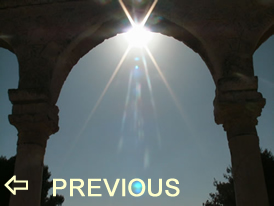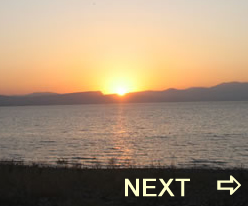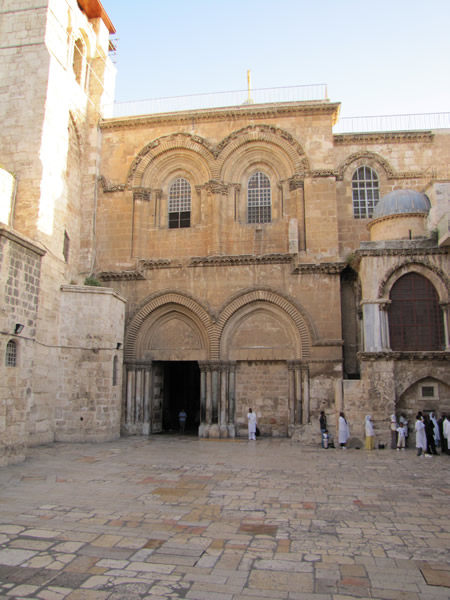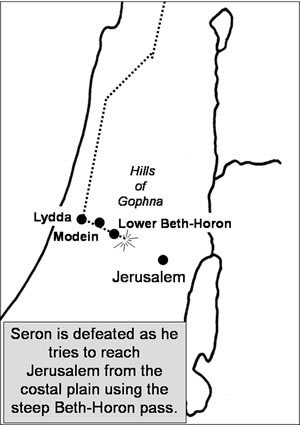| |

|
October 13 - Evening
"When Saul came to Jerusalem, he tried to join the disciples, but they were all afraid of him, not believing that he really was a disciple. But Barnabas took him and brought him to the apostles. He told them how
Saul on his journey had seen the Lord and that the
Lord had spoken to him, and how in Damascus he
had preached fearlessly in the name of Jesus.
So Saul stayed with them and moved about freely
in Jerusalem, speaking boldly in the name of the
Lord. He talked and debated with the Hellenistic Jews, but they tried to kill him. When the believers learned of this, they took him down
to Caesarea and sent him off to Tarsus."
- Acts 9:26-30 |
 |
|
| Saul Joins the Church in Jerusalem |
|
|
Saul, the great persecutor of the church, had left Jerusalem three years before to arrest the
believers who had fled his persecution. Now, the same man returns to Jerusalem professing that Jesus was the Messiah. Obviously, the Jerusalem church was suspicious! There is no better
way to get to the heart of the church than to feign allegiance. But, Saul’s “friendship” problems and trust issues reached further than the fact his former enemies were leery of his motivation. It is a known practice that a Jew who confessed Jesus as Messiah could be cut off socially from his Jewish culture which would include employment, family relations, inheritance and social status. So, Saul returns to the glorious city of Jerusalem rejected by Jewish society and unwelcomed in the church.
An acquaintance of Saul’s, possibly from his earlier days, named Barnabus trusted Saul’s
conversion and believed his intentions were pure. We can speculate that Barnabus, who himself
was a Jew from a foreign land of Cyprus (near Paul’s home country of Cilicia) and a Levite, may
have known Saul before either of their conversions. Barnabus who must have known Saul’s
integrity “brought him to the apostles.” (Barnabus’ name was Joseph and his spiritual gift was encouragement which he used to edify the church, thus his name Barnabus, Bar Newaha
[Aramaic], or Son of Encouragment, Acts 4:36. So, Barnabus’ spiritual gift became his name.)
While in Jerusalem Paul says in Galatians he only met Peter and James, the brother of Jesus.
“After three years I went up to Jerusalem to get to know Peter, and stayed with him for fifteen days. But I saw none of the other apostles, except James, the Lord’s brother.”
– Galatians 1:18
Saul began to debate his former Greecian Jewish friends in the synagogue concerning the Messiahship of Jesus. Most likely, because of his superior training and excellent debate skills,
Saul believed he could reason with the Jews and lead them to a glorious revival to their Messiah Jesus. But, to Paul’s disappointment they responded just like he had previously and vowed to kill
him. So, after a fifteen day “revival” in Jerusalem Saul fled for his life back to his home country. |
|
 |
"To read in the Bible, as the word of God himself that,
'In the sweat of thy face
shalt thou eat bread,'
and to preach therefrom that, 'in the sweat of other man's faces shalt thou eat bread,'
to my mind, can scarcely be reconciled with honest sincerity."
- Abraham Lincoln
|
 |
The Jordan River begins at
the base of Mount Hermon
and drops 3,300 feet in elevation before it reaches
the Dead Sea. |
|
| |
 |
|
 |
Ploutos (Gr) - Riches (Eng) - the Greek word ploutos is where the English gets the word
plutonic (rock formed by solidification at a great depth below the earth's surface) and
plutocrat (government by the wealthy). The Greek word ploutos originally referred
to abundant wealth and riches in the Greek language. In the philosophy of Plato (400 BC)
the concept of ploutos divided into material ploutos and ploutos that was not material things,
but yet very beneficial to society. This second division included things such as wisdom,
character, education, etc. The New Testament uses ploutos to refer to great
physical wealth, but also to spiritual wealth as in Ephesians:
"..the forgiveness of sins, in accordance with the riches (ploutos) of God's
grace that he lavished on us..." - Ephesians 1:7-8 |
|
Skeptics rejected the existence of Belshazzar and the biblical account in Daniel 5 and 8. The discovery of a couple of clay cylinders in the 1854 and 1880's that had belonged to Babylonian King Nabonidus mention his son Belshazzar. On these clay cylinders inscribed in cuneiform text from the
500's BC King Nabonidus prays for his son Belshazzar on one cylinder and mentions Belshazzar on the other.
The cylinders were found in Ur and Sippar. They are about four inches long. This find confirms the fact that whoever wrote the book of Daniel had to be an eye witness of the events in Daniel 5 and 8 since history from 450 BC and down does not record Belshazzar. These cylinders completely undermine the textual critics who claim that the book of Daniel was a forgery written around 165 BC, instead of
by Daniel himself in the
500's BC as the author of
the book claims.
(Photos here and here.
More information here) |
| |
|
|
 |
|
 |
Do I use my spiritual gift? Do I allow God to minister to others through me?
I will trust God to provide opportunities and provide the strength to minister to people.
|
|
"He who walks with the wise grows wise, but a companion of fools suffers harm."
- Proverbs 13:20 |
| |
|
|
|
 |
|
| |
|
 |
 |
 |
 |
| Children |
Avoid immorality |
Health care |
Russia - minority groups face exploitatino and rejection |
|
|
| |
 |
 |
 |

One of the early battles of the Maccabean Revolt where
Judas and his forces defeat Seron on the Beth-Horon Pass. |
This is the entrance to the Church of the Holy Sepulcher. The current building was inaugurated by the Crusaders who rebuilt it in 1149. This site was
honored by first century Christians, buried by Hadrian in 135, identified by
local believers in 326, covered by Constantine’s church by 335, which
was thendestroyed by the Persians in 614, only to be rebuilt and
destroyed again by the Muslim Caliph Hakim in 1009. The right (east)
half of the main entrance to the church was walled shut by the Muslims
after the Crusaders lost Jerusalem in 1187.
(click on image for larger size) |
General Seron leeads
the 6,000 Seleucid troops down the Mediterranean coast
then turns east towards Jerusalem through Lydda and
up the steep ascent of Beth-horon. Judas chooses to
meet him with his 1,200 men on a steep narrow pass
between Lower Bethhoron and Upper Beth-horon.
Judas again divides his men into three groups.
Two on the sides of the pass and he and
his elite troops called "The Faithful" at the
head of the pass. General Seron crosses the
Plain of Sharon and tokes the first valley that leads to Jerusalem. This road ascends 1,500 feet in two miles
and at times is a narrow trail. At the top of a
narrow trail Judas shows himself and his elite troops.
Seron decides he could easily drive through the few Maccabean troops. Seron continues up the pass to reach Judas only to find himself trapped. Then Judas sounds
the shofars and the archers and slingers
fire on the trapped Seleucid troops.
Seron is killed and the Seleucids tear off their armor,
throw down their weapons and are chased back to the
costal plain. Judas has now defeated two generals and defeated two armies. The surrounding nations begin to talk about the Macabees in Judah. The Maccabee revolt has become a major rebellion against Antiochus IV Epiphanes. |
| |
|
| Details and Explanation of Sets & Reps Devotional System Here |
 |
|
|
| |
| |
| |
| Reps & Sets is a daily Bible devotional for Christians from Generation Word Bible Teaching used each morning and evening. |
| |
|